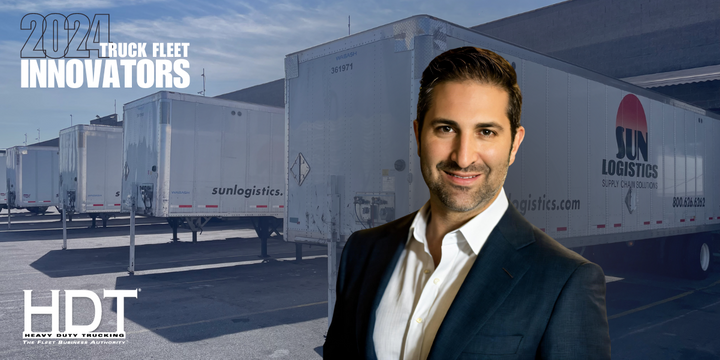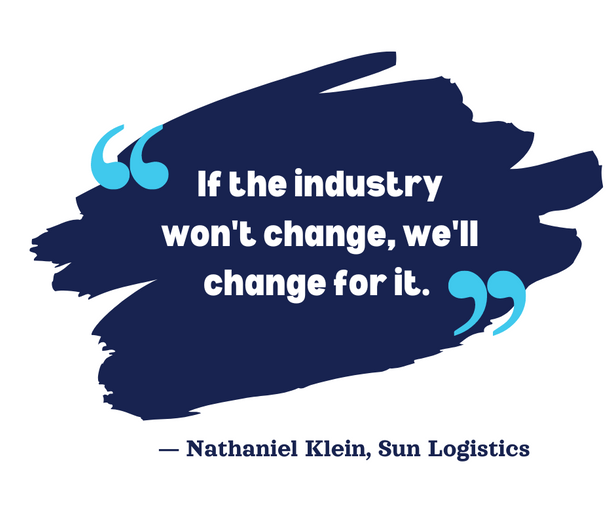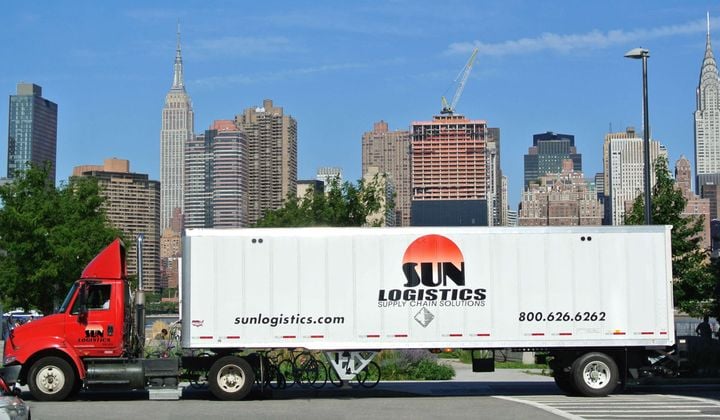Trucker Access › Forums › Diesel News › Bringing Fresh Eyes and New Technology to LTL – Fleet Management
- This topic has 0 replies, 1 voice, and was last updated 9 months, 2 weeks ago by
 EazyRiDer66.
EazyRiDer66.
-
AuthorPosts
-
June 25, 2024 at 2:45 am #27163
 EazyRiDer66Keymaster
EazyRiDer66Keymaster

HDT Truck Fleet Innovator Nathaniel Klein worked with Wabash to develop trailer specs suited to tight urban operations.
Image: HDT Graphic | Sun Logistics photos
When Nathaniel Klein walks the docks at Sun Logistics, he sometimes gets questions from dock workers concerned about the health of the company, because it seems like there’s so much less freight they’re handling than they used to.
“And I was like no, no, we’re actually doing more freight than ever. It’s just easier now. Because we’ve brought our average number of touches per piece of freight down to 1.7 from somewhere around 5.”
When Klein joined Maspeth, New York-based Sun Logistics a few years ago, he was able to bring a fresh perspective to the family-owned business. The changes he has spearheaded led to HDT’s editors naming Klein a 2024 Truck Fleet Innovator.
Sun Logistics specializes in less-than-truckload last-mile and first-mile services in New York City and Miami, with about 150 drivers operating per day.
“I didn’t come from the trucking industry, I came from multiple other industries,” says Klein, who is now chief operating officer. He brought more than 20 years of experience in private equity, mergers and acquisitions, and operations, focusing on companies going through transitions.
“So when I got in here, I scratched my head quite a bit. Just because everyone says, ‘This is how it’s always been done,’ doesn’t mean it’s the right way of doing it.”
The LTL industry is dominated by a relatively small number of large carriers, which Klein believes lessens their motivation to invest in major changes.
“The inefficiency within this industry is dramatic,” Klein says. “And if you came to our facility, you would see we have zero paper on the dock. We have automated text messaging going back and forth, everything being data-driven to make decisions.

“Basically the system runs itself. And we run it on exceptions, versus everyone entering data and trying to figure out, ‘What does this mean?’”
One of the first things he did was replace the old green-screen AS400 mainframe computer systems with newer cloud-based technology, including. using Carrier Logistics Inc.’s FACTS transportation management system for LTL. But he didn’t stop there.
“If you ask CLI, we’re pushing them to their furthest limits,” he says.
Automating Delivery Appointments
For instance, less than a year ago, Sun Logistics rolled out a new automated text messaging/email system for setting up appointments.
When the company receives an EDI (Electronic Data Interchange), the new system sends the customer a text message and an email offering a choice of appointment dates.
“Within 10 minutes, 80% of them reply back and say okay, this is the day we want,” Klein says.
The system follows up with texts confirming the appointment, reminding the customer the night before of the appointment, and notifying the customer that the delivery is about 15 minutes away.
“It’s hard for customer service to do that, be on top of it that much,” Klein says. “You’re giving them that experience that even though they didn’t think they needed until Amazon rolled it out, we’re giving you that experience as well.”
Smarter Routing with Real-Time Data
The company also is using computer-driven decisions for routing and routes. Previously, Klein says, supervisors had to try to figure out the best routes to combine manually.
“There’s no way they could figure out 700 stops in their head,” he says. “They used to have papers they used to move around.”
He explains that Sun Logistics has built a “brain” on top of the CLI software, the carrier’s own data warehouse in Microsoft SQL Azure.
“Within that, it decides all our decisions of where our routes should be, how we’re making those routes,” he says.
The results have been dramatic in terms of metrics such as on-time deliveries and returns (drivers coming back with deliveries they were unable to make.)
Machine learning, a form of artificial intelligence, has helped Sun Logistics slash high return rates.
“Even though people say they know what time their dock is open, for the most part, most docks in New York City stop receiving at 2:00 in the afternoon,” Klein says. Even though most say they are open until 5 p.m.
“I could show you, the return rate skyrockets from around 2% before 2:00. After 2:00, it goes to around 10%. And after 3:00, it goes to 20%.
“So what we’ve done with that information [on when docks really close] is, how do we make our routes so tight, and so concise, that drivers are done with deliveries by 2:00 and now they’re just doing pickups” the rest of the afternoon.
Standardizing EDI and Other Formats
Klein says he’s been able to use technology to deal with EDI transactions that aren’t all using the same standard.
The big LTLs largely have each created their own system, he says, and there’s not an overarching EDI standard used by everyone.
“Everyone says ‘My EDI is a standard,’ when it’s really not a standard. And even within their own system, they all do different EDI.”
Sun Logistics has created a funnel, he says, that takes different EDI formats, and even non-EDI information such as a photo of the delivery receipt (proof of delivery).
“We’ll take it in, we standardize it within our own system. And however information went in, we funnel it back out again” in the same format.
“Our goal is to keep the information standard within ourselves. Some companies can’t send us EDI, so they send us a picture of the DR. Our [optical character reader] AI takes that DR and puts all the information into our system. Our tablets have the DRs on it as well, so the driver knows exactly what they’re delivering.”
“If the industry won’t change, we’ll change for it. And hopefully we can lead it to the right place. A lot of our big carriers, we become their R&D lab.”
In fact, some of its carrier customers have purchased the code for that “brain” Klein built on top of CLI.
Enter Artificial Intelligence
Artificial intelligence has made much of this possible. Klein notes that AI has been around for 15 years or so. All the attention and advances the past couple of years have been regarding LLMs, large language models, which have made possible generative AI such as ChatGPT.
“AI before LLM, we call machine learning,” he explains. “We have already been implementing machine learning on how to make the best routes.”
Machine learning can look at the data coming in every day and learn from it. For instance, if there’s a neighborhood where a lot of people celebrate an ethnic or religious holiday and there were deliveries that couldn’t be completed, it learned that at this time of year there were a lot of returns in that neighborhood and take that into account when planning routes.
Smart Delivery Appointments
Sun Logistics is using LLM AI for its new text and email appointment system.
“The next thing we’re rolling out is, I’ll call it an AI bot that calls you that uses natural language; it sounds like a person. It says, ‘Hey, Deborah, your generator’s in, would next Tuesday work for a delivery?’ You would have no clue that you’re talking to a computer, but you are talking to a computer.”
Since the answer will likely be yes or no, the AI would use that answer to ask the next question, such as, ‘Would Wednesday work?’
“If you then say no to that, then we could bring in someone in the office, or we could solve it still with a few other questions, like, ‘You tell us what day you would like that freight delivered.’
“So that’s what we’re testing right now.”
Klein estimates that combined, the text message, email and voice call AI could lead to a 50% reduction in fixed costs in the office.
“So we’re using AI throughout, a lot in the OCR, a lot on how we do planning. And now we’re moving to LLM with our appointments, status and stuff like that.”
Being Where Others Don’t Want to Be
Sun Logistics focuses on New York and Miami, Klein explains, “Where we just mainly do last and first mile for large carriers that don’t want to, or logistics companies that don’t operate in New York City or Miami.
“New York City, people think it’s a horrific area, maybe it is, maybe it’s not, but we like to be places where others don’t want to be.”
One thing the company has done is develop trailers specifically for the challenges of those dense urban areas. 53-foot trailers aren’t easy to get around with in Brooklyn or the Bronx, so Sun Logistics has a lot of 28-foot trailers, every one with a liftgate.
And these trailers are only 12 feet 6 inches high instead of 13 inches.
“We found that there’s a lot of wires, especially in New York City, lines that dropped to 13 feet. So you’d go down a street and take down all the internet and it’s a disaster.”
The carrier worked with Wabash to create these shorter trailers designed for Sun’s operations.

Data-driven decisions and artificial intelligence are helping Sun Logistics operate with maximum efficiency.
AI and Data Analytics Still Need People Power
But all the technology and innovation still depends on people.
When Klein came into Sun Logistics, he found an operation with great people but technology and processes that needed updating. So he expected some pushback on implementing changes.
Klein was able to make some changes — not even technology, but operational changes — and those worked.
“And once those worked, they all said, ‘What else can we do?’”
And the technology frees people up from mundane tasks and allows them to focus more on the kinds of creative thinking that aren’t easily automated.
Klein says Sun Logistics offers incentives to employees that meet key performance indicators.
“A large percentage of our profit every month, minimum of 4 to 5%, every month goes back to the team. And that’s not the annual bonus, that’s just to say, hey, we’re aligned with each other. The more money the company makes, the more money you guys make.”
-
AuthorPosts
- You must be logged in to reply to this topic.